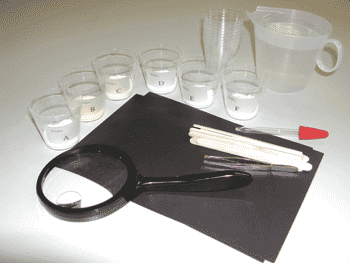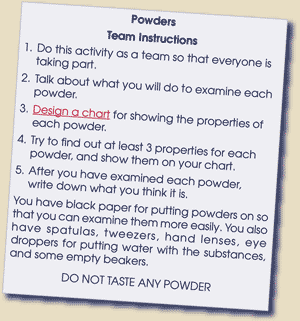|
||||||||||||
|
||||||||||
| Questions/instructions:
|
||||||||||
| %
responses 2003 ('99) |
||||||||||
| y8
|
||||||||||
Team
work:
|
||||||||||
Involvement
– |
all
students substantially involved |
90
(84) |
||||||||
one
student not substantially involved |
9
(14) |
|||||||||
Division
of labour – |
students
worked together on all samples |
39
(26) |
||||||||
informal
division of samples within group |
52
(70) |
|||||||||
deliberate
allocation to different students |
9
(4) |
|||||||||
Reporting
results – |
all
had a turn |
94
(92) |
||||||||
one
did not have turn |
3
(8) |
|||||||||
two
or more did not have turn |
3
(0) |
|||||||||
Style
of investigating – |
highly
systematic |
19
(7) |
||||||||
quite
systematic |
34
(33) |
|||||||||
somewhat
haphazard |
39
(48) |
|||||||||
very
haphazard |
8
(12) |
|||||||||
produced
information in chart form |
81
(57) |
|||||||||
Substance
A – |
identified as Ajax |
17
(7) |
||||||||
2
or more relevant observations |
51
(37) |
|||||||||
1
relevant observation |
19
(31) |
|||||||||
Substance
B – |
identified
as citric drink |
99
(54) |
||||||||
2
or more relevant observations |
69
(42) |
|||||||||
1
relevant observation |
13
(27) |
|||||||||
Substance
C – |
identified as flour |
75
(93) |
||||||||
2
or more relevant observations |
55
(44) |
|||||||||
1
relevant observation |
18
(31) |
|||||||||
Substance
D – |
identified
as washing powder |
95
(68) |
||||||||
2
or more relevant observations |
61
(44) |
|||||||||
1
relevant observation |
12
(22) |
|||||||||
Substance
E – |
identified
as salt |
46
(73) |
||||||||
2
or more relevant observations |
55
(40) |
|||||||||
1
relevant observation |
14
(22) |
|||||||||
Substance
F – |
identified
as baking soda |
38
(50) |
||||||||
2
or more relevant observations |
44
(44) |
|||||||||
1
relevant observation |
24
(21) |
|||||||||
Total
score: |
20–22
|
14
(4) |
||||||||
16–19
|
35
(22) |
|||||||||
12–15
|
21
(20) |
|||||||||
8–11
|
11
(30) |
|||||||||
4–7
|
15
(22) |
|||||||||
0–3
|
4
(2) |
|||||||||
| Commentary There are surprising fluctuations between 1999 and 2003, with some substances handled much better in 1999 and others in 2003. Overall, performance was markedly higher in 2003 than in 1999. |
||||||||||
| |
||

